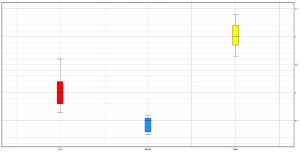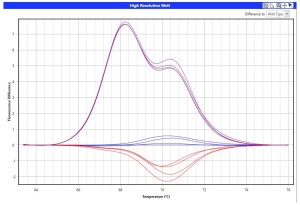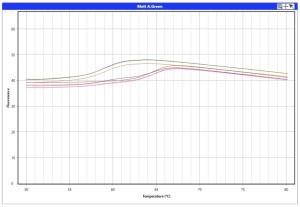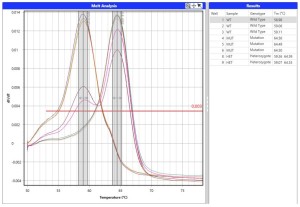Mic – Personal qPCR Cycler
The world’s first Magnetic Induction Cycler.
The box is small. The ideas are big.
Meet Mic
Hardware:
Mic uses a patented magnetic induction technology to heat your samples and fan forced air for cooling. This means fast qPCR results through rapid heating and cooling with 35 cycles possible in under 25 minutes*.
Back that up with a robust optical system that acquires all channels simultaneously and running multiplexed assays has never been quicker. The Mic real-time cycler is available in either 2 or 4 channel models.
Each channel uses an independent high intensity LED, photodetector and filter set combining together to give unparalleled detection performance.
With a fixed optical path and no moving parts there is never any optical alignment or calibration required. Even better is that no reference dyes or crosstalk compensation is required.

*Assays designed toward cDNA targets with short amplicon sizes and using fast cycling compatible polymerases
![]()
Mic delivers unrivaled reproducibility between samples, runs and instruments. Real-time PCR replicates have never looked so good and detection of two-fold differences in gene expression levels never easier.
Why wait to run 384 samples? Get your results now and have the confidence your datasets can be seamlessly combined using our Projects analysis software. Comparing samples between multiple runs or even multiple instruments is effortless. Check out some of our data here.
To achieve this level of quantification precision, the Mic real-time cycler incorporates a unique spinning aluminium rotor which has unsurpassed temperature uniformity during both dynamic and static operations. All other block-based real-time cyclers only promise static uniformity, which could lead to variability as samples aren’t heated and cooled at the same rate.
Combine temperature accuracy of ±0.25ºC, a first class well-to- well temperature uniformity of ±0.05ºC, and superior equilibration time (zero seconds for all wells to reach the same temperature) and you can easily classify difficult class IV SNPs that require melt temperature resolutions of less than 0.1ºC.
You might think this level of performance requires constant calibration of your machine, but Mic’s good to go right out of the box.
You don’t need to calibrate – ever.
![]()
Mic takes up less space on the bench than your lab book. And weighing in at just 2kg, this is the most portable and compact qPCR machine on the market. Even four Mic’s stacked together take up less bench space than your current cycler.

Only magnetic induction technology by way of its elegant simplicity makes it possible to achieve such a small qPCR instrument footprint.
The Mic tube format uses 0.1mL strips of four tubes and matching caps, supporting volumes of 5 to 30µL. A tab on the first tube ensures correct orientation of tubes at all times.
High speed centrifugation ensures samples spin down at the start of a run and the pre-loaded oil overlay inside each tube prevents evaporation and condensation. We have eliminated the need for bulky heated lids and external centrifuges whilst simultaneously improving the quality of results.
These benefits are only possible because of Mic’s unique rotary and magnetic induction cycler technology.
![]()
Multiple Mic instruments can be operated from one workstation so 48 becomes 96, and 96 becomes 192. As many as ten instruments can connect to one PC. Bluetooth technology means fewer cables too.

With the latest addition to Mic’s powerful software, it is easy to combine data from multiple runs from multiple machines into one dataset for analysis. Mic’s thermal and optical performance is so reproducible your data looks like it was generated from the same qPCR machine. For more information on the software click here.
Naturally, you want to be up and running as quickly as possible so installation for the instrument has been made plug-and-play. It’s as simple as installing the software and starting your first run.
Specs

(click to enlarge)
Physical:

Electrical:
AC Input: 100 – 240 VAC, 50/60Hz 4.0
Thermal Performance:
Temperature Accuracy: +/- 0.25°C
Temperature Uniformity: +/- 0.05°C
Ramp Rates: Heating 4°C/s. Cooling 3°C/s.
Optical:
Detectors: Photodiode per channel
Excitation Sources: High energy light emitting diode for each channel
Channels:
- Green: Ex 465nm Em 510nm
- Yellow: Ex 540nm Em 570nm
- Orange: Ex 585nm Em 618nm
- Red: Ex 635nm Em 675nm
Reaction Vessels:
Samples per Instrument: 47
Reaction Volume Range: 10 – 25ul
Operating Environment:
Temperature: 18 – 35°C
Relative Humidity: 20 – 80%
Software:
It’s not just the hardware that’s more refined. Mic’s software is user-friendly and packed with intelligent features.
Designed to meet MIQE specifications, Mic’s software offers you the most up-to-date qPCR analysis. With an intuitive interface, setup and analysis is simple, while further control features give you total confidence in your data.

 (click to enlarge)
(click to enlarge)
Mic’s RQ software uses up-to-date mathematical models and well-founded statistical analysis, allowing you to compare gene expression levels for different targets across multiple groups. All the necessary calculations and statistics are carried out within the software. Data is reported both numerically and graphically. With Mic’s superior temperature uniformity, detect difference between samples as little as 0.2 fold.

Mic’s optional HRM software characterises DNA samples according to their melt behaviour so you can identify mutations, including difficult Class IV SNPs (in example red samples contain the A base allele, blue T base allele, and purple are heterozygote). HRM is the perfect tool for applications including determining allele prevalence, screening for loss of heterozygosity, DNA fingerprinting, DNA methylation, species identification and calculating the ratio of somatic acquired mutations.

Using a standard curve, AQ allows you to determine the absolute amount of a genetic target. This 5 point, twofold dilution series produced an efficiency of 98%. The percentage variation between the given and calculated concentrations was no greater than 5%, allowing for accurate quantification of the unknown sample.

Use differential melt curves from various types of chemistries, including quenched FRET dual hybridization probes, beacon probes or Plexor to characterise a sample’s genotype. Melt peaks can be inverted to accommodate the different chemistry types.
Created by Bio Molecular Systems
Mic is developed and manufactured by Bio Molecular Systems (BMS), the original team behind Rotor-Gene 6000™, X-Tractor Gene™ and CAS-1200™.
At BMS, we’re committed in helping you further with your research in the life sciences. Founded by leading innovators of the former Corbett Life Sciences Company, we draw on decades of expertise when designing, manufacturing and distributing our laboratory instruments of unparalleled accuracy and functionality.
With two state-of-the-art R&D and manufacturing facilities located near Brisbane and Sydney, we’re able to optimise quality and ensure rapid product development.












